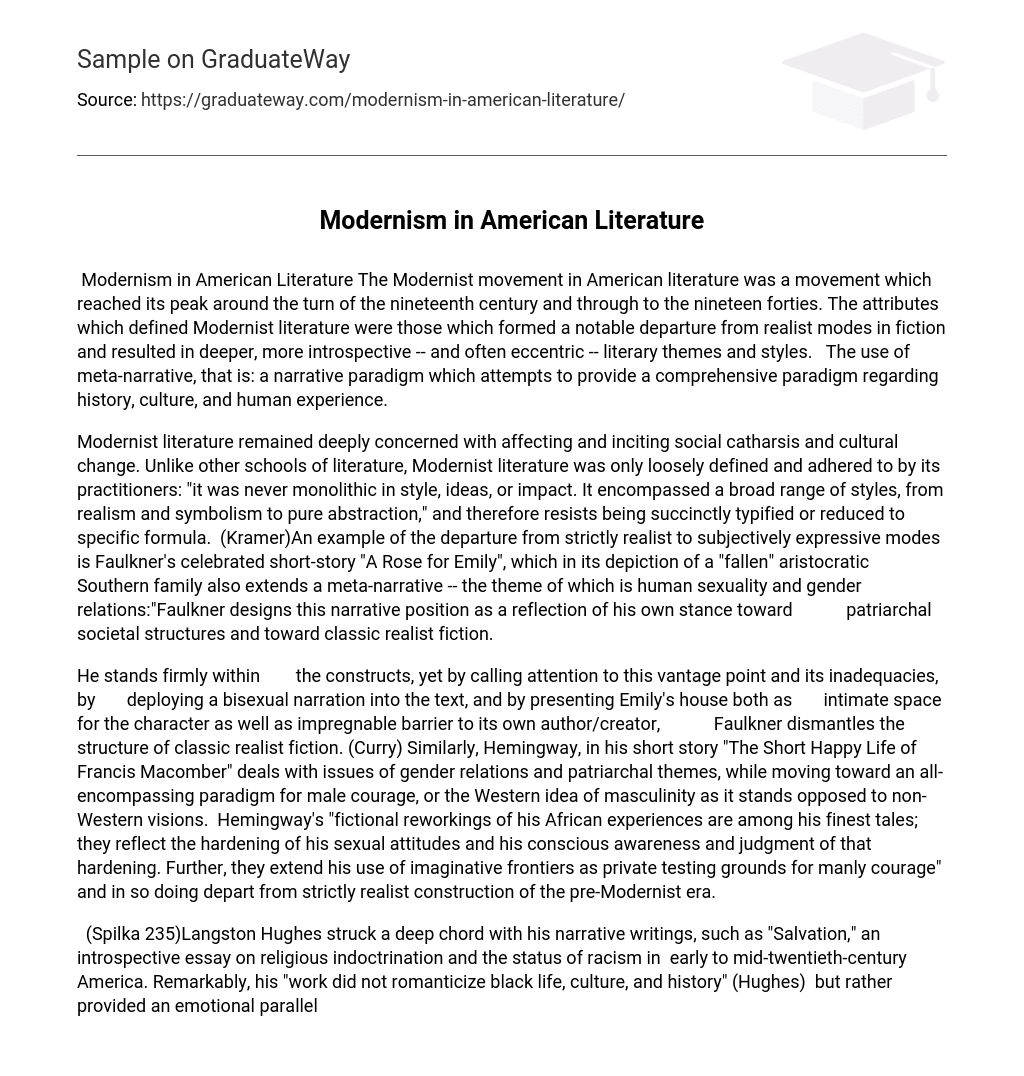Modernism in American Literature The Modernist movement in American literature was a movement which reached its peak around the turn of the nineteenth century and through to the nineteen forties. The attributes which defined Modernist literature were those which formed a notable departure from realist modes in fiction and resulted in deeper, more introspective — and often eccentric — literary themes and styles. The use of meta-narrative, that is: a narrative paradigm which attempts to provide a comprehensive paradigm regarding history, culture, and human experience.
Modernist literature remained deeply concerned with affecting and inciting social catharsis and cultural change. Unlike other schools of literature, Modernist literature was only loosely defined and adhered to by its practitioners: “it was never monolithic in style, ideas, or impact. It encompassed a broad range of styles, from realism and symbolism to pure abstraction,” and therefore resists being succinctly typified or reduced to specific formula. (Kramer)An example of the departure from strictly realist to subjectively expressive modes is Faulkner’s celebrated short-story “A Rose for Emily”, which in its depiction of a “fallen” aristocratic Southern family also extends a meta-narrative — the theme of which is human sexuality and gender relations:”Faulkner designs this narrative position as a reflection of his own stance toward patriarchal societal structures and toward classic realist fiction.
He stands firmly within the constructs, yet by calling attention to this vantage point and its inadequacies, by deploying a bisexual narration into the text, and by presenting Emily’s house both as intimate space for the character as well as impregnable barrier to its own author/creator, Faulkner dismantles the structure of classic realist fiction. (Curry) Similarly, Hemingway, in his short story “The Short Happy Life of Francis Macomber” deals with issues of gender relations and patriarchal themes, while moving toward an all-encompassing paradigm for male courage, or the Western idea of masculinity as it stands opposed to non-Western visions. Hemingway’s “fictional reworkings of his African experiences are among his finest tales; they reflect the hardening of his sexual attitudes and his conscious awareness and judgment of that hardening. Further, they extend his use of imaginative frontiers as private testing grounds for manly courage” and in so doing depart from strictly realist construction of the pre-Modernist era.
(Spilka 235)Langston Hughes struck a deep chord with his narrative writings, such as “Salvation,” an introspective essay on religious indoctrination and the status of racism in early to mid-twentieth-century America. Remarkably, his “work did not romanticize black life, culture, and history” (Hughes) but rather provided an emotional parallel in narrative form for the experience of African Americans. Hughes writes in “Salvation:” And the church sang a song about the lower lights are burning, some poor sinners to be saved. And the whole building rocked with prayer and song.
Still I kept waiting to see Jesus. Finally all the young people had gone to the altar and were saved, but one boy and me. (Hughes) The expression of personal experience is made through a narrative paradigm which includes a universal abstraction: the place of the individual in regards to God or religion.The poet William Carlos Williams found similar capacity from fusing the objective world with the personal insight or emotion.
His famous poem “The Red Wheelbarrow” asserts a meta-narrative paradigm on the decline of agriculture in America. For Williams poetry resided in everyday things: ” the concrete object was appropriated by W. C. Williams,” but by fusing one’s subjective vision with universal paradigms by way of objective things poetry was created.
(Hutner 289)Like Williams, Robert Frost extended the Modernist lament for the vanishing bucolic America into poetry. His poem “The Road Not Taken” successfully merges personal with social, and universal expression. The tension produced in the poem by the contrast of the trivial and the profound; these elements comprise the poem’s universality and also demonstrate the fusing in Modernist literature of personal and objective themes. Works CitedCurry, Renee R.
“Gender and Authorial Limitation in Faulkner’s “A Rose for Emily.” The Mississippi Quarterly 47.3 (1994): 391+.Hughes, Langston.
“Salvation.” Free Inquiry Summer 1999: 47+.Hutner, Gordon. American Literature, American Culture.
New York: Oxford University Press, 1999.Kramer, Hilton. “Modernism & Its Institutions.” New Criterion Oct.
2003: 4+.Spilka, Mark. Hemingway’s Quarrel with Androgyny /. Lincoln, NE: University of Nebraska Press, 1990.





